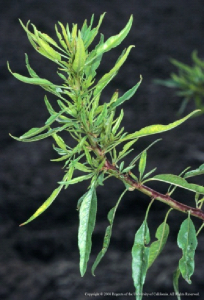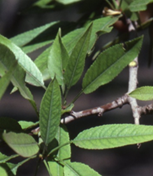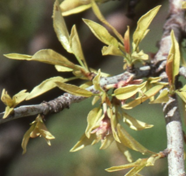Potassium, zinc, iron, and manganese nutrient deficiency symptoms are more prevalent where soils are wet, cold, and saturated. Reduced root activity and nutrient uptake can produce pale leaf color or interveinal chlorosis (pale or yellowing between the veins in the leaf). Micronutrient deficiencies often show symptoms in only a small part of an orchard, or, if due to saturated soil or flooding, may only appear during part of the season. Foliar nutrient sprays can provide quick correction of symptoms and improve tree color and vigor if indeed that is the reason trees were performing poorly in the first place.
When thinking about fertility in your orchard, the first step is to review tree nutrient status by re-examining your leaf tissue analysis from last July to determine if any nutrients are borderline or deficient. Root activity increases when soils warm and dry out, hence, deficiency symptoms may correct themselves as spring progresses. For every 1000 pounds of almond kernels hauled to the huller (hulls, shells and kernels), 60-80 lbs. of potassium, 1.1 oz. of zinc, 3.0 oz. of iron, and 0.7 oz. of manganese are exported with the crop. Fertilizing with potassium and zinc is often required but most soils normally supply the tiny amounts of iron and manganese necessary to meet tree needs unless soils are cold and wet. If truly deficient, symptoms will persist and will be reflected in this year’s July leaf analysis.
Potassium (K)
When first leafing out, trees displaying K deficiency symptoms appear pale in color and have small leaves with little new growth. Later, trees show rolled leaves with marginal leaf burning. This symptom is classic when it occurs in the tree top on leaves in the middle of new shoot growth. The Butte variety is a good indicator of this deficiency because it is likely to exhibit leaf scorching before other varieties show symptoms. K is deficient if July leaf analysis is below 1.0%.
A true K deficiency can be corrected now by foliar sprays of potassium nitrate when sufficient material is applied. The standard approach that corrected K deficiency for the season in the past applied 40 pounds of potassium nitrate per acre with each of the three 400 gallon dilute applications for a total of 120 pounds of potassium nitrate per acre. In a typical concentrate spray applied at 100 gal/ac, rates of 20-30 pounds of potassium nitrate per acre can be safely applied to almonds to provide the boost needed in a wet spring.
Zinc (Zn)
Zinc is part of the enzyme system that regulates terminal growth and plant cell expansion. Trees with severe deficiency may experience dormant flower bud drop and decreased fruit set, will have shortened internodes and small ‘little leaf’ symptoms, and have chlorotic leaves with wavy margins. With mild deficiency, leaves may be slightly smaller than normal with areas of interveinal chlorosis. Young trees can be deficient without showing any visual symptoms so it is important to get a July tissue analysis even in young orchards. Zinc is deficient if a July leaf analysis is below 15 ppm.

Zinc deficiency symptoms in almond. Photo: UC IPM.
Foliar sprays to correct Zn deficiency are effective and inexpensive. A spring foliar treatment can be timed once leaves have attained nearly full size. On spring foliage, basic zinc sulfate or zinc oxide sprays are normally safe and effective. Either form can be applied at 5 pounds per 100 gallons of water or at 15 pounds per acre when sprayed at 100 gallons water per acre. Rain within 48 hours of zinc foliar applications can reactivate the zinc and produce phytotoxic “shot-hole” symptoms on leaves.
Iron (Fe) and Manganese (Mn)
Both iron and manganese are important in chlorophyll formation so a deficiency of either show as interveinal chlorosis in young leaves. Deficiencies in iron and manganese although rare in the Sacramento Valley, are occasionally seen in orchards with soil pH above 7.5, on calcareous soils, or on heavy or poorly drained soils.
Iron deficiency causes interveinal yellowing with the small leaf veins remaining green. When severe, leaves will be uniformly yellow throughout the leaf (Fig. 2). Iron deficiency may show early in the season and continue until leaves yellow and drop or it may show in the spring and then gradually disappear as soils warm up and dry out.

Mild iron deficiency symptoms. Photo: J.H. Connell.
Leaf analysis is not a reliable indicator of iron deficiency so learn to recognize leaf symptoms. Trees will green up if foliar sprays of Sequestrene® 138 Iron Chelate or other similar iron materials are applied following label instructions.

Severe iron deficiency symptoms. Photo: J.H. Connell.
Manganese chlorosis appears as a herring bone pattern with major veins green between yellow interveinal areas. Manganese is adequate when July leaf analysis is over 20 ppm. Manganese deficiency can be corrected with foliar sprays of manganese sulfate at 2 pounds per 100 gallons water sprayed at 100 gallons per acre. If you have a small problem area, banded soil applications of manganese sulfate at 10 pounds per tree have been effective for longer term correction.


Leave a Reply